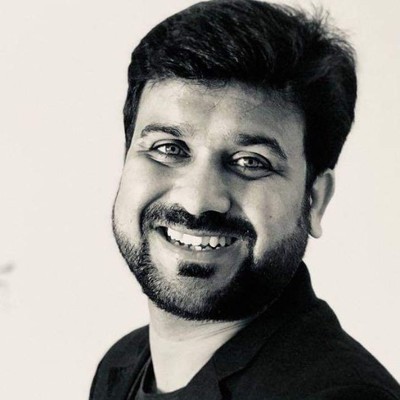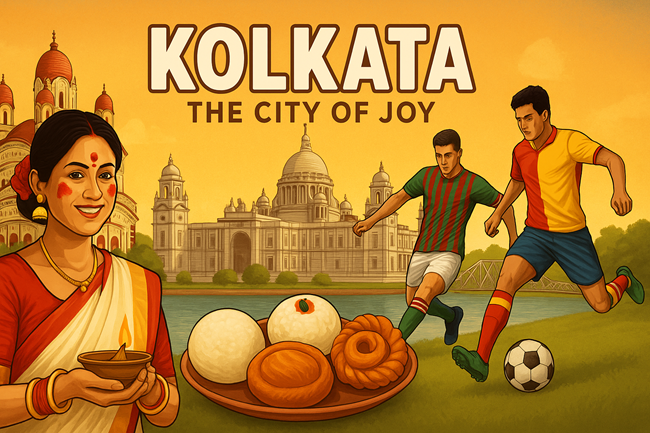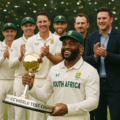Why Kolkata is Called the ‘City of Joy’
Welcome to Kolkata—a city that doesn’t just live, it celebrates life. Called the City of Joy for its indomitable spirit, artistic soul, festive heartbeat, and warmth of its people, Kolkata is more than just a destination—it’s an emotion. The name gained fame through Dominique Lapierre’s novel “ City of Joy“, but the ethos goes far beyond literature. From timeless traditions to cutting edge creativity, Kolkata offers a mesmerizing blend of old and new that captivates every traveler.

History of Kolkata The City Of Joy (Calcutta): Where the Past Still Breathes
Kolkata’s story began in 1690, when Job Charnock, an agent of the British East India Company, chose it as a trading post. It grew rapidly, becoming the capital of British India until 1911. The city became the center of the Bengal Renaissance, nurturing poets, freedom fighters, and reformers like Rabindranath Tagore, Swami Vivekananda, and Subhas Chandra Bose.
The echoes of colonialism, revolution, and art still resonate in its architecture, culture, and conversations.
Famous Personalities Born in Kolkata – Legends That Define the City
Kolkata isn’t just a city of heritage and food—it is a cradle of genius. From Nobel laureates to film maestros, freedom fighters to sports icons, some of India’s brightest minds and bravest hearts were born in the City of Joy. Here’s a look at a few legends who shaped not just Kolkata, but the entire nation.
Rabindranath Tagore
Born: May 7, 1861
Legacy: The first Asian Nobel Laureate in Literature (1913), Tagore was a poet, painter, philosopher, and the composer of India’s national anthem. Born in Jorasanko Thakur Bari, his ancestral home is now a museum and a major tourist spot.
Why He Matters: Tagore’s literary brilliance and vision for a progressive India made him a global cultural icon. His presence defines Kolkata’s reputation as the intellectual capital of India.
Swami Vivekananda
Born: January 12, 1863
Legacy: The dynamic monk who introduced Indian spirituality to the West at the 1893 Parliament of Religions in Chicago. His birthplace on Gourmohan Mukherjee Street is now a revered heritage site.
📝 Why He Matters: A symbol of youth empowerment and spiritual strength, Vivekananda gave Kolkata its spiritual backbone.
Subhas Chandra Bose (Netaji)
Born: January 23, 1897
Legacy: One of India’s most courageous freedom fighters and the leader of the Indian National Army (INA). His ancestral home in Kolkata, Netaji Bhawan, is now a museum.
Why He Matters: Known for his fearless patriotism, Netaji’s call “Give me blood, and I will give you freedom” continues to echo through Kolkata’s revolutionary past.
Satyajit Ray
Born: May 2, 1921
Legacy: An Oscar-winning filmmaker, Ray is known for his masterful storytelling in films like Pather Panchali and the Apu Trilogy. His works elevated Indian cinema to international heights.
📝 Why He Matters: Ray’s genius continues to inspire generations of filmmakers. His connection to Kolkata is immortalized through various film festivals, institutes, and his residence.
Sourav Ganguly
Born: July 8, 1972
Legacy: Former Indian cricket team captain and ex-BCCI President, Ganguly is one of India’s most successful cricketers. Affectionately called ‘Dada’, he hails from Behala, South Kolkata.
📝 Why He Matters: His fearless leadership transformed Indian cricket, and his love for Kolkata is reflected in his deep involvement with local sports and charities.
Mother Teresa (Honorary Mention)
While not born in Kolkata (born in Skopje, Macedonia), Mother Teresa made Kolkata her life’s mission, founding the Missionaries of Charity and serving the city’s poorest with love and dignity.
📝 Why She Matters: Her legacy of compassion lives on in every corner of the city, especially at Mother House, her final resting place.
Manna Dey, Kishore Kumar, and Usha Uthup
Kolkata also gave the world some of its most iconic musicians and singers:
- Manna Dey: Classical and playback singer extraordinaire.
- Kishore Kumar: Though born in Madhya Pradesh, his roots and early stardom are connected to Kolkata.
- Usha Uthup: The queen of stage performance and Indipop, she still lives and performs in the city.
Kolkata’s Legacy of Talent Continues
These personalities are not just local legends—they are national treasures, deeply woven into Kolkata’s cultural fabric. Whether through books, speeches, films, or cricket stadiums, their influence continues to shape the city’s identity and inspire millions of visitors every year.
Durga Puja: The Soul of Kolkata
Durga Puja is not just a festival—it’s Kolkata’s heartbeat. Celebrated over 10 days in October, the entire city transforms into a living art gallery with themed pandals, illuminated streets, and cultural performances.
Artistic Pandals
Each pandal is an artistic marvel—some mimic international landmarks, others showcase social messages, all adorned with elaborate lighting.
Cultural Fusion
From traditional dhunuchi dance, shlokas, and dhaak beats to rock concerts, poetry readings, and fashion parades—it’s a celebration of both tradition and modernity.
Food Stalls
Every lane has makeshift food courts offering rolls, biryani, sweets, and bhog (offering). You’ll walk miles, eat endlessly, and never get tired.
📍 Why Visit During Durga Puja?
Because Kolkata becomes magic. The warmth, hospitality, creativity, and community spirit are unlike anything you’ll experience elsewhere.
Football: A Religion in Kolkata
If cricket is India’s first love, football is Kolkata’s obsession. The city is home to some of the country’s oldest and most passionate clubs:
🔹 Mohun Bagan AC – Established in 1889
First Indian club to defeat a British team in 1911 IFA Shield. This historic win is celebrated even today.
🔹 East Bengal FC – Founded in 1920
Known for its fiery fanbase and intense rivalry with Mohun Bagan.
🔹 Kolkata Derby
The East Bengal vs Mohun Bagan match is more than a game—it’s a cultural war. The Salt Lake Stadium, one of the largest in Asia, often hosts over 80,000 screaming fans.
🔹 Grassroots Love
From school tournaments to para (neighborhood) football, the love for the game starts early. Adda sessions, club jerseys, street matches—football pulses through the veins of every Kolkatan.
Top Tourist Attractions in Kolkata The City Of Joy – With History and Significance
1. Victoria Memorial
A symbol of British grandeur, this white marble monument was built in 1921 in memory of Queen Victoria. Blending British and Mughal architecture, it now houses a museum with 25 galleries, including the famed Calcutta Gallery that narrates the city’s colonial past.
📍 Significance: Testament to Kolkata’s imperial legacy.
2. Howrah Bridge (Rabindra Setu)
Inaugurated in 1943, this cantilever bridge is one of the busiest in the world. It connects the twin cities of Howrah and Kolkata over the Hooghly River and sees over 100,000 vehicles and pedestrians every day.
📍 Significance: Engineering marvel and cultural symbol of Kolkata.
3. Dakshineswar Kali Temple
Built in 1855 by Rani Rashmoni, this majestic temple is dedicated to Goddess Kali and holds deep spiritual ties with Ramakrishna Paramahamsa, who lived here for years.
📍 Significance: Sacred spiritual center, offering peace and powerful energy.
4. Kalighat Temple
One of the 51 Shakti Peethas, where the right toe of Goddess Sati is believed to have fallen. It’s one of the holiest shrines for devotees of Goddess Kali and is deeply intertwined with Kolkata’s identity.
📍 Significance: Spiritual epicenter; centuries-old pilgrimage site.
5. Indian Museum
Established in 1814, it is India’s oldest and largest museum. It houses an extensive collection of ancient artifacts, fossils, Mughal-era paintings, and even an Egyptian mummy.
📍 Significance: A walk through India’s ancient to colonial history.
6. Park Street
Known as the “Street That Never Sleeps,” Park Street is lined with colonial-era clubs, modern cafes, heritage restaurants, bookstores, and live music venues. It becomes magical during Christmas when the entire stretch lights up.
📍 Significance: Heart of Kolkata’s social, culinary, and festive life.
7. Kumartuli
This artisan village is where Durga idols are handcrafted every year. Generations of potters live and work here, shaping divine beauty out of clay. Visit during August–October for an unforgettable experience.
📍 Significance: Cultural lifeline of Durga Puja artistry.
8. College Street & Indian Coffee House
Asia’s largest second-hand book market is a haven for bibliophiles. Nearby, Indian Coffee House is where revolutionaries, writers, and intellectuals once debated over endless cups of “infusion.”
📍 Significance: Intellectual and literary soul of the city.
Kolkata’s Street Food: A Feast for the Soul
Food in Kolkata isn’t just sustenance it’s emotion. Bengali street food combines tang, spice, and texture in unforgettable ways.
🔹 Puchka (Bengali Pani Puri)
Unlike its cousins across India, Kolkata’s Puchka is filled with mashed potatoes, tangy tamarind water, and spicy masalas. It’s a must try!
🔹 Kathi Roll
Invented in Kolkata, this is a paratha rolled with juicy fillings like kebab, paneer, or egg, along with onion and chutney.
🔹 Telebhaja
Deep fried snacks like beguni (brinjal fritters), alur chop (potato fritters), and mochar chop (banana flower cutlets).
🔹 Momo
Tibetan style dumplings that have become a city wide obsession, often served with spicy red chutney.
🔹 Ghugni Chaat
A spicy preparation of dried yellow peas with chopped onion, chillies, and tamarind simple yet explosive in flavor.
🔹 Mishti (Sweets)
You can’t miss Rasgulla, Sandesh, Mishti Doi, and Chhanar Jilipi. Each sweet has a history and technique passed down through generations.
Best Time to Visit Kolkata
- October–March: Pleasant weather + festival season = best time to explore the city.
- Durga Puja in October and Christmas at Park Street in December are unforgettable experiences.
Travel Tips for Kolkata Visitors
- Respect temple customs (remove shoes, dress modestly)
- Street food is safe—go where locals go
- Use Metro for convenient, fast travel
- Carry cash for local shops and autos
- Shop for sarees at Gariahat, books at College Street, and art at New Market
Conclusion: Kolkata Will Stay in Your Soul
Kolkata doesn’t entertain you—it envelops you. It teaches you to enjoy the little joys of life—a cup of tea at a street corner, a spontaneous adda session, or the glow of fairy lights during Durga Puja. Whether you’re an artist, foodie, historian, or just a curious traveler, Kolkata will feel like home.
Frequently Asked Questions (FAQs) About Kolkata The City Of Joy
Q1. Why is Kolkata called the ‘City of Joy’?
Kolkata earned the name ‘City of Joy’ due to its warmth, cultural richness, and resilient spirit. The nickname was popularized by Dominique Lapierre’s novel, but locals and travelers agree—it’s a city that celebrates life in every moment.
Q2. What is the best time to visit Kolkata?
The ideal time is October to March, especially during Durga Puja (October) and winter festivities. The weather is pleasant and perfect for sightseeing, food exploration, and attending cultural events.
Q3. What are the top 5 must-visit places in Kolkata for tourists?
- Victoria Memorial
- Howrah Bridge
- Dakshineswar & Kalighat Temples
- Indian Museum
- Kumartuli (idol-making district)
These spots offer a mix of history, architecture, spirituality, and local culture.
Q4. What is special about Durga Puja in Kolkata?
Durga Puja in Kolkata is a 10-day cultural explosion. Grand pandals, goddess idols, street food, music, art, and community spirit fill the streets 24/7. It’s the best time to witness Kolkata’s culture in full glory.
Q5. What are the best street foods to try in Kolkata?
- Puchka (Bengali pani puri)
- Kathi Rolls
- Telebhaja (deep-fried fritters)
- Ghugni Chaat
- Momos
- Mishti Doi & Rasgulla
Every street corner has a new taste waiting for you!
Q6. Is Kolkata safe for solo travelers, including female travelers?
Yes, Kolkata is generally safe, especially in tourist zones. Use public transport like Metro, avoid secluded areas late at night, and trust local hospitality, which is famously warm and helpful.
Q7. What is the local language in Kolkata? Can I manage with English or Hindi?
The local language is Bengali, but English and Hindi are widely understood, especially in tourist areas, hotels, and markets. Most locals are multilingual and happy to help.
Q8. What festivals besides Durga Puja are popular in Kolkata?
- Kali Puja (around Diwali)
- Christmas (especially on Park Street)
- Poila Boishakh (Bengali New Year)
- Saraswati Puja (celebrated by students)
- Eid and Muharram, celebrated with harmony and color
Q9. How can I travel within Kolkata?
- Metro (fast, cheap, reliable)
- Yellow Taxis & App-based cabs (Ola/Uber)
- Auto-rickshaws and Trams (a heritage ride)
- Ferries across the Hooghly River for scenic travel
Q10. What are the best markets for shopping in Kolkata?
- New Market: For clothes, shoes, accessories
- Gariahat Market: Sarees, handicrafts
- College Street: Books of all kinds
- Dakshinapan: Traditional artifacts and boutiques
Q11. What are some good local dishes to try apart from street food?
- Shorshe Ilish (Hilsa in mustard sauce)
- Chingri Malai Curry (Prawns in coconut gravy)
- Luchi & Aloor Dom (Bengali-style puri and potato curry)
- Kosha Mangsho (spicy mutton curry)
- Bhapa Doi (steamed sweet yogurt dessert)
Q12. What is Kolkata’s connection with football?
Kolkata is often called the football capital of India. The rivalry between East Bengal and Mohun Bagan is legendary. Local tournaments, massive fan culture, and grassroots-level enthusiasm make football a city-wide passion.
Q13. Are there any day trips I can take from Kolkata?
Yes! Great day trips from Kolkata include:
- Sundarbans (mangrove forests & Bengal tiger reserve)
- Shantiniketan (Tagore’s university town)
- Diamond Harbour (riverside escape)
- Bishnupur (famous for terracotta temples)
Q14. How many days are enough to explore Kolkata?
To truly enjoy Kolkata’s culture, food, and top attractions, you should plan for 4 to 5 days. Add more if you wish to take nearby day trips or attend Durga Puja.
Read more about Rajasthan Travel Guide 2025 , Kerala Travel Guide in Monsoon and Goa in Monsoon Travel Guide on Popnewsblend.

Hi, I’m Prashant Jain — a curious soul, storyteller, and content creator at heart.I’ve always been drawn to the world of entertainment, travel, sports, health & lifestyle — not just as a writer, but as someone who genuinely lives these experiences. Whether I’m binge-watching the latest OTT series, exploring offbeat spiritual destinations in India, or diving deep into wellness routines and cricket match insights, I love sharing what I discover with like-minded readers.
PopNewsBlend is my way of blending personal journeys with meaningful stories — ones that inform, inspire, and keep you ahead of the curve. Everything I write comes from real observations, hands-on experiences, and a deep passion for understanding the world around us.
Discover more from Popnewsblend
Subscribe to get the latest posts sent to your email.








Pingback: My Journey to Nepal: A Soulful Adventure Through the Himalayas, Heritage, and Heart - Popnewsblend